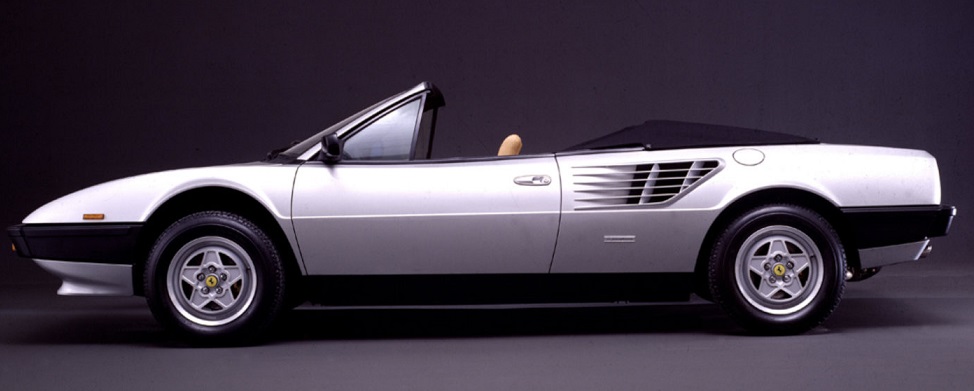

Convertible, 2 Doors, 4 Seats
240 Hp @ 7000 rpm.
82 Hp/l
240 km/h 149.13 mph
2927 cm3
178.62 cu. in.
8, V-engine
Rear wheel drive,
4580 mm
180.31 in.
1790 mm
70.47 in.
1430 kg
3152.61 lbs.
| Brand | Ferrari |
|---|---|
| Model | Mondial (Convertible) |
| Version | Mondial Cabrio |
| Engine version | 8 Quattrovalvole (240 Hp) |
| Year production start | 1983 |
| Year production end | 1987 |
| Vehicle type | Convertible |
| Horsepower RPM | 240 Hp @ 7000 rpm. |
| Curb weight kg -lbs total |
1430 kg3152.61 lbs. |
| Overall length mm - inch |
4580 mm180.31 in. |
| Doors | 2 |
| Top Speed | 240 km/h 149.13 mph |
| Designation model | F105A |
|---|---|
| Cam configuration | DOHC |
| Engine position and orientation | Middle, Transverse |
| Cylinders | 8 |
| Position of cylinders | V-engine |
| Displacement (liters) |
2927 cm3178.62 cu. in. |
| Eng. horsepower RPM | 240 Hp @ 7000 rpm. |
| Horsepower per litre | 82 Hp/l |
| Weight / horsepower kg/hp - hp/tons |
6 kg/Hp167.8 Hp/tonne |
| Weight / torque kg/Nm - Nm/tons | 5.5 kg/Nm, 181.8 Nm/tonne
5.5 kg/Nm181.8 Nm/tonne |
| Torque Nm RPM lb-ft RPM |
260 Nm @ 5000 rpm.191.77 lb.-ft. @ 5000 rpm. |
| Bore (mm in) |
81 mm3.19 in. |
| Stroke (mm in) |
71 mm2.8 in. |
| Compression ratio | 9.2 |
| Fuel delivery system | Multi-point indirect injection |
| Fuel type | Petrol (Gasoline) |
| Valvetrain | 4 |
| Engine aspiration | Naturally aspirated engine |
| Engine oil liters | quarts |
10 l10.57 US qt | 8.8 UK qt |
| Engine coolant |
15 l15.85 US qt | 13.2 UK qt |
| Powertrain architecture | Internal Combustion engine |
| Engine location | Middle, Transverse |
| Drive configuration | Rear wheel drive |
|---|---|
| Transmission | 5 |
| Front brakes | Ventilated discs |
|---|---|
| Rear brakes | Ventilated discs |
| Steering type | Steering rack and pinion |
|---|---|
| Turning diameter m - ft |
12 m39.37 ft. |
| Front suspension | Wishbone, Transverse stabilizer |
|---|---|
| Rear suspension | Wishbone, Transverse stabilizer |
| Passengers seats | 4 |
|---|---|
| Trunk space min liter | cu. Ft. |
300 l10.59 cu. ft. |
| Overall length mm - inch |
4580 mm180.31 in. |
|---|---|
| Overall width mm -inch |
1790 mm70.47 in. |
| Overall height mm -inch |
1260 mm49.61 in. |
| Wheelbase mm - inch |
2650 mm104.33 in. |
| Track width front mm - inch |
1495 mm58.86 in. |
| Track width rear mm - inch |
1517 mm59.72 in. |
| Curb weight kg -lbs total |
1430 kg3152.61 lbs. |
|---|---|
| Fuel tank liters | gallons |
87 l22.98 US gal | 19.14 UK gal |
8 CYLINDER V-Engine
https://www.thecarspec.net/components/engine/8-cylinders-v